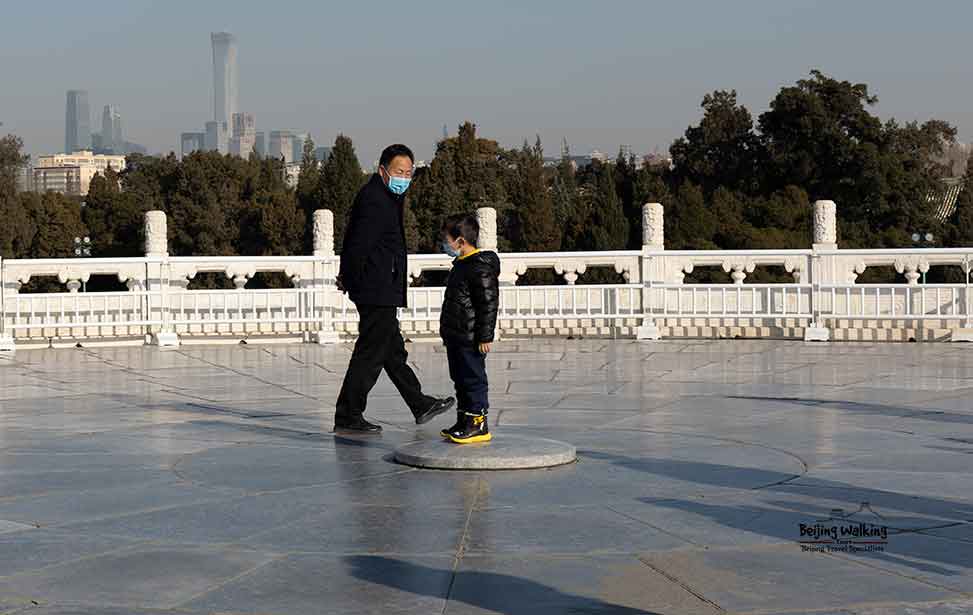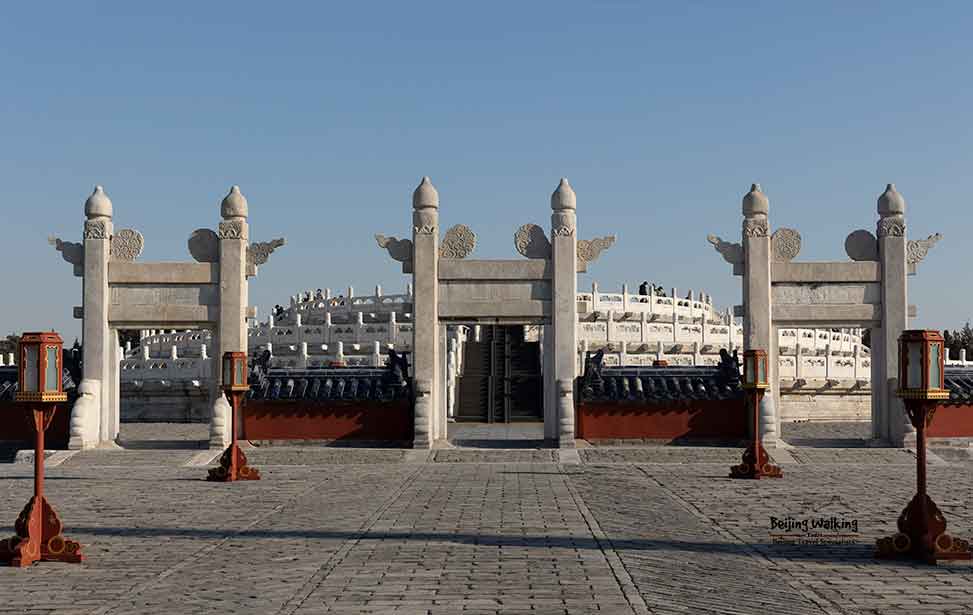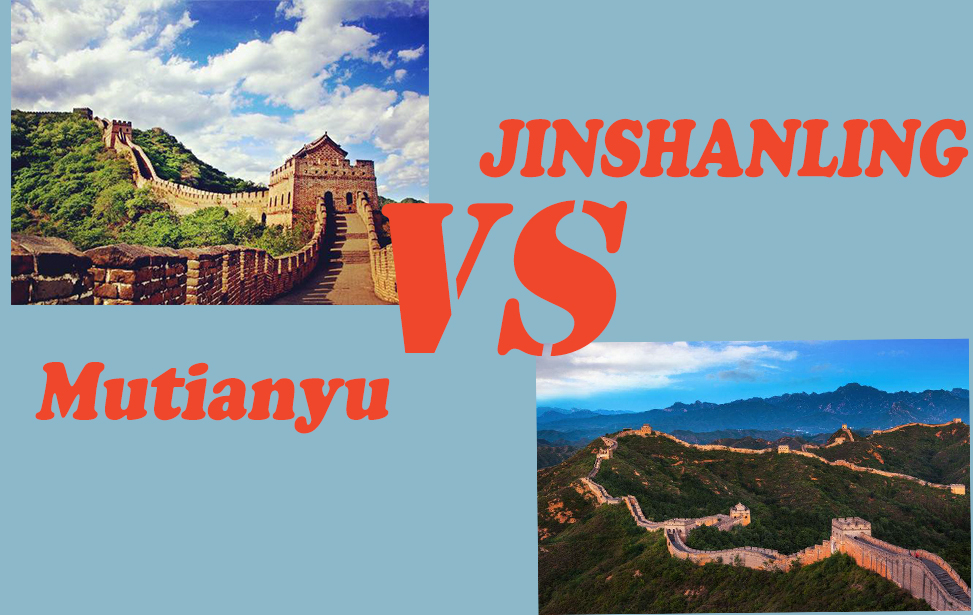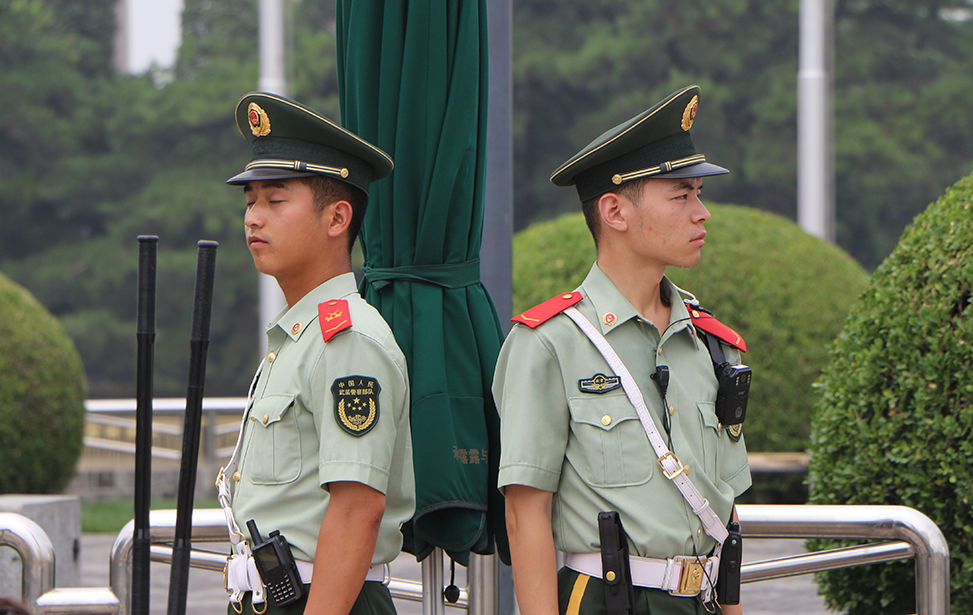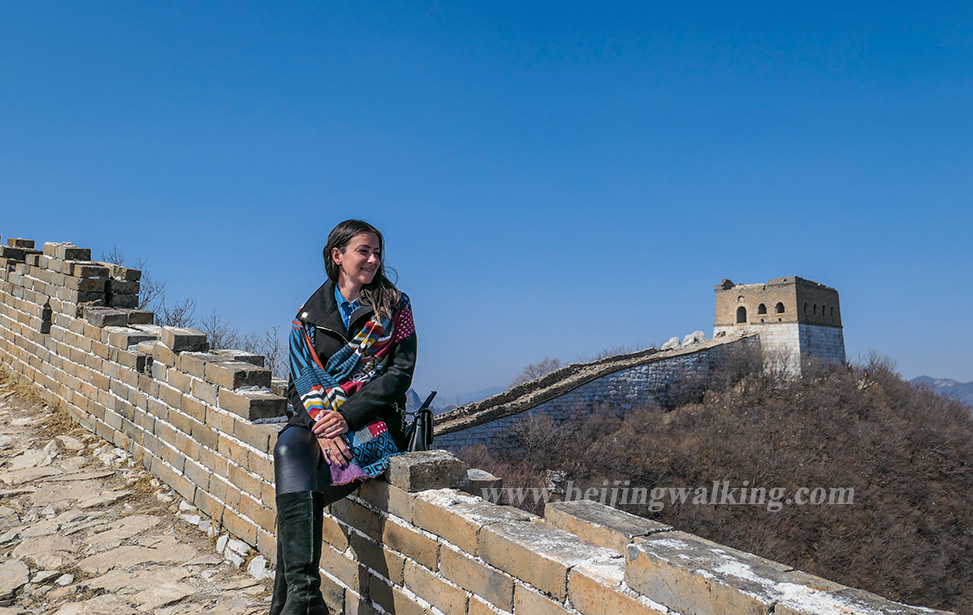The Ultimate Guide to Temple of Heaven in 2025
Welcome to the Temple of Heaven, an enduring symbol of ancient imperial power in China, graciously welcoming visitors to Beijing. This iconic landmark stands as a testament to the grandeur of old China. It is one of the earliest structures constructed during the Ming Dynasty’s capital relocation from Nanjing to Beijing. With its roots dating back to the 15th century, this magnificent complex served as a sacred sanctuary where Ming and Qing emperors conducted solemn rituals and offered prayers for bountiful harvests. In this blog, we invite you to delve into the historical significance, explore the key attractions, and discover practical tips for an unforgettable visit to the Temple of Heaven.
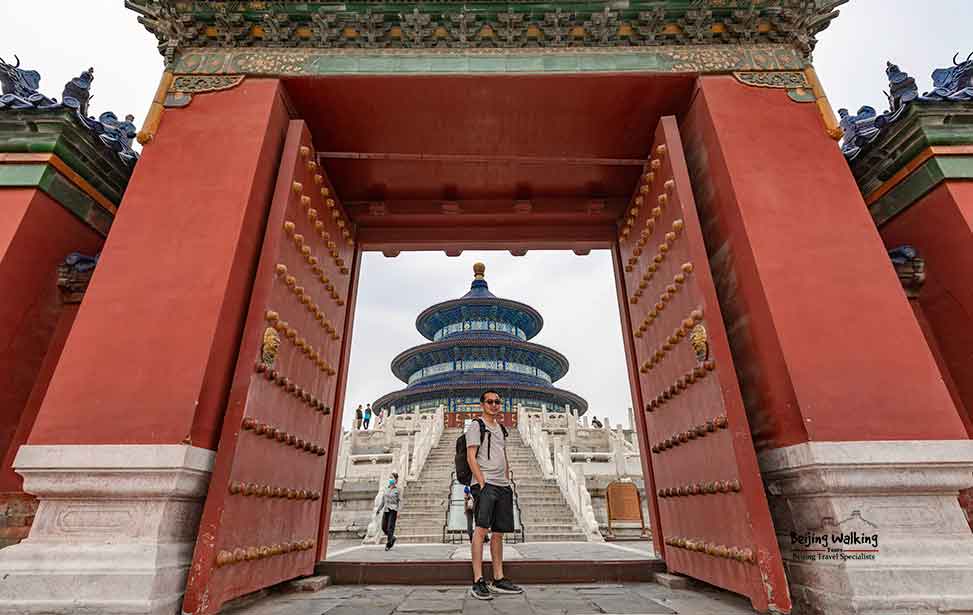
1. 10 facts about the Temple of Heaven
- They were built in the 15th century as a religious complex for emperors to perform rituals.
- The architectural design symbolizes the harmony between heaven and earth.
- The Hall of Prayer for Good Harvests is the most iconic building in the complex.
- The Circular Mound Altar is a sacred stone platform for prayer ceremonies.
- The Echo Wall allows whispers to be heard clearly from one end to the other.
- The Temple of Heaven is a UNESCO World Heritage Site.
- The complex features several other structures, including the Imperial Vault of Heaven.
- The number nine holds special significance in the design and layout of the complex.
- It served as a venue for critical annual ceremonies during the Ming and Qing dynasties.
- The Temple of Heaven hosts a vibrant temple fair during Chinese festivals.
2. Temple of Heaven Logistics
How to get there?
Address: No. 7 Tiantann-nei-dongli, Dongcheng District, Beijing Address in Chinese: 北京市东城区天坛内东里7号
The nearest subway station is Tiantandongmen station on line 5. Take a taxi to the east gate: Please take me to the East Gate of the Temple of Heaven 请带我去天坛东门
Opening Hours
Busy season:(1st April to 31 October)
Low season:(1st November to 31 March)
Main Gate open time:
Busy season:6:00-21:00
Low season:6:30-21:00
Close time:22:00
Hall of Prayer for good harvest, Echo Wall and Circular Mound Altar, The Office Of Divine Music
Busy season:8:00-17:30
Low season:8:00-17:00
The Palace for Abstinence; Butcher Pavilion:
Tuesday to Sunday Morning,9:00—12:00 Afternoon 13:00—16:00
Temple of Heaven tickets
There are many different prices for the tickets. Buying tickets through Tickets allows you to visit all the other gardens inside.
Busy season:34RMB
Low season:28RMB
How do you buy the Temple of Heaven tickets?
You can go to the entrance to buy the tickets or use WeChat to book it online. At WeChat, you should search “天坛门票.” Don’t forget to bring your passport with you.
For foreign tourists, buying tickets from the ticket office is easy. But it would be best to show the passport for real-name access. If you are visiting during the Chinese holidays, it is better to book the tickets before. You can ask your Chinese friend or your hotel to book the tickets through WeChat by searching “天坛门票.”
Temple of Heaven’s official site: http://www.tiantanpark.com/
Audio guide:
You can find the audio guide at each Temple of Heaven entrance. The Chinese Language is 20RMB, and any other language is 40RMB.
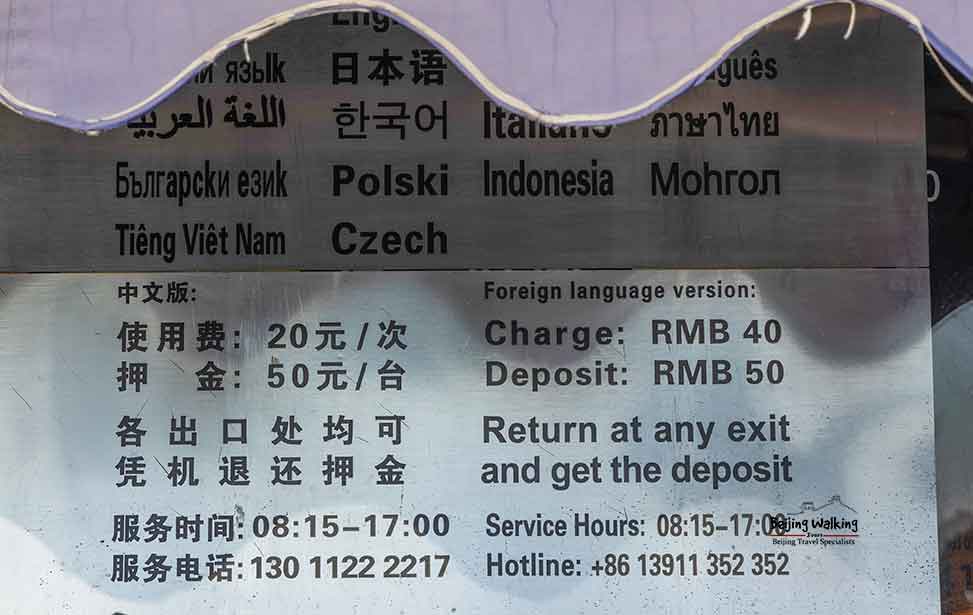
3. A Glimpse into History:
Step into the Temple of Heaven and immerse yourself in centuries of history and spirituality.
The Temple of Heaven is a religious building that served the emperor from the Forbidden City. Its construction history and background are the same as those of the Forbidden City.
1420 – The Ming Emperor Yongle Zhu Di moved the capital from Nanjing to Beijing. The temple was built by copying the Temple of Heaven and Earth in Nanjing. The Main building is called the Hall of Dasi.
1530 – Ming Emperor Zhu Houcong built the Circular Mound Altar south of the Temple of Heaven and Earth to worship heaven. And made the Temple of Earth at the north of the Forbidden City. Hall of Dasi is renamed Hall of Daxiang for praying for a good harvest, and the roof has three colors (blue, yellow, and green)
1791 – Emperor Qianlong changed the name from Hall of Daxiang to Hall of Prayer for Good Harvest in the Qing Dynasty. Change the roof to a blue color only.
1911 – The worship of Heaven was abolished
1918 – The Temple of Heaven was officially open to the public.
4. Must-See Attractions:
a. Hall of Prayer for Good Harvests: The iconic Hall of Prayer for Good Harvests is the centerpiece of the Temple of Heaven. Admire its magnificent triple-tiered wooden structure, adorned with intricate carvings and vibrant colors. This awe-inspiring hall is an architectural marvel and a symbol of imperial worship.
b. Circular Mound Altar: Explore the Circular Mound Altar, where emperors would offer sacrifices to the heavens. The circular marble terrace, ornate railings, and central stone slab represent the connection between heaven and earth.
c. Echo Wall and Three Echo Stones: Experience a fascinating acoustic phenomenon at the Echo Wall. Whisper a message against the wall, and it will be heard by someone standing on the opposite side. Nearby, the Three Echo Stones offer a similar effect, creating a unique interactive experience.
d. Imperial Vault of Heaven and Divine Music Administration: Discover the Imperial Vault of Heaven, a smaller circular building that houses ceremonial tablets. Adjacent to it is the Divine Music Administration, where music was performed during religious ceremonies.
5. Travel Route
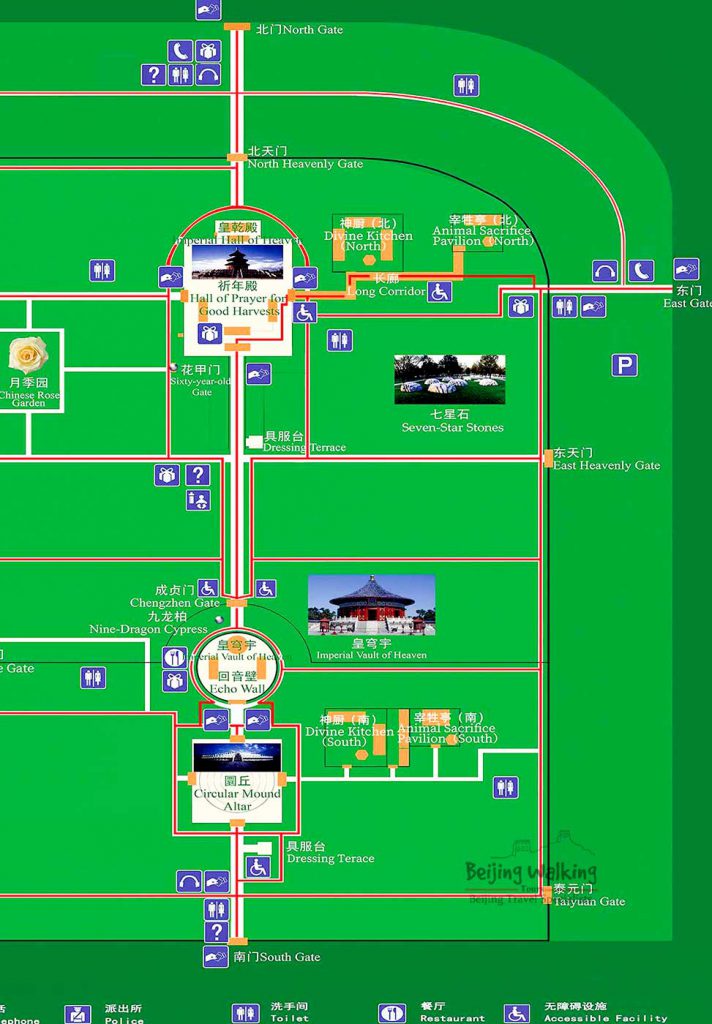
There are two altars: the Circular Mound Altar in the south and the Altar of Praying for grain in the North. The Red Stairway bridge connects the two altars.
The Axis of the Temple of Heaven runs from north to south, connecting the Circular Mound Altar and the Altar of Praying for Grain. Usually, you can walk through the Axis and don’t miss all the highlights.
Start from the east gate 东门晨练
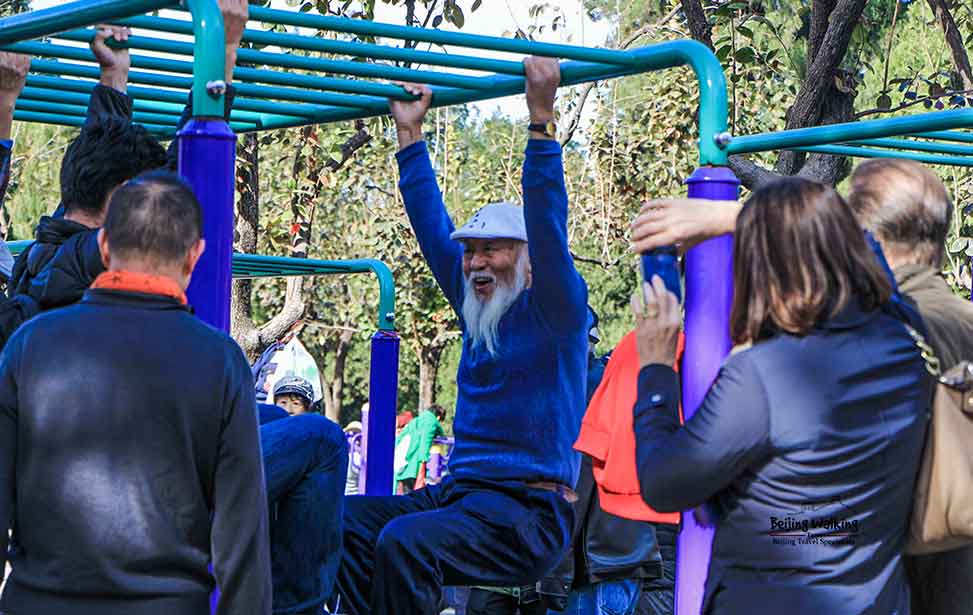
The most interesting for travelers is to watch the locals doing morning exercise. This is an excellent way to enjoy the authentic local life; the training starts early in the morning and continues until 11 am. You can also find the wedding market near the seven-start stone.
Long Corridor 长廊
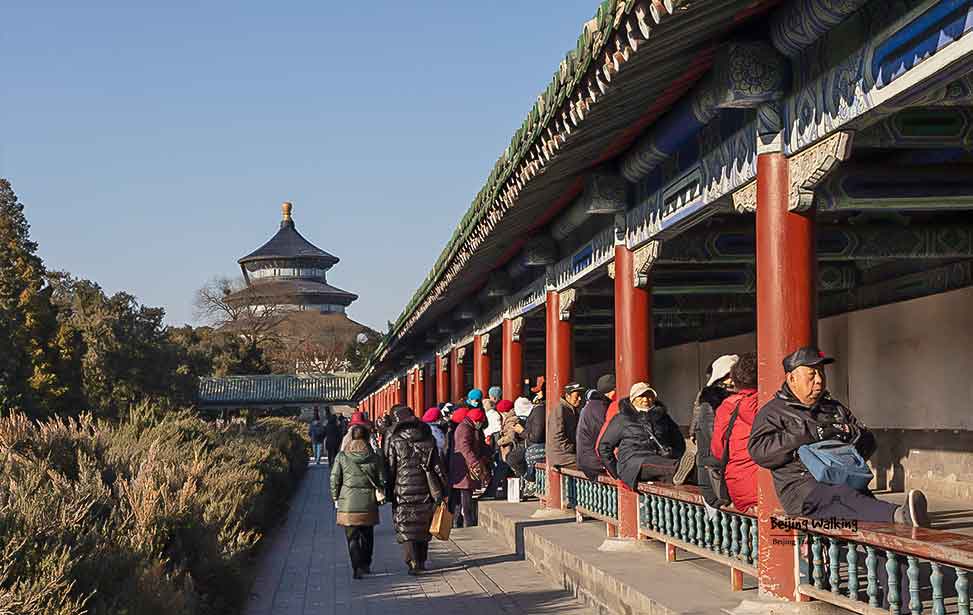
It is located outside the Hall of Prayer for Good Harvest and has 72 rooms lined along its length. It is used to prevent the contamination of sacrifices by rain, snow, and sandstorms.
Hall of Prayer for Good Harvest 祈年殿
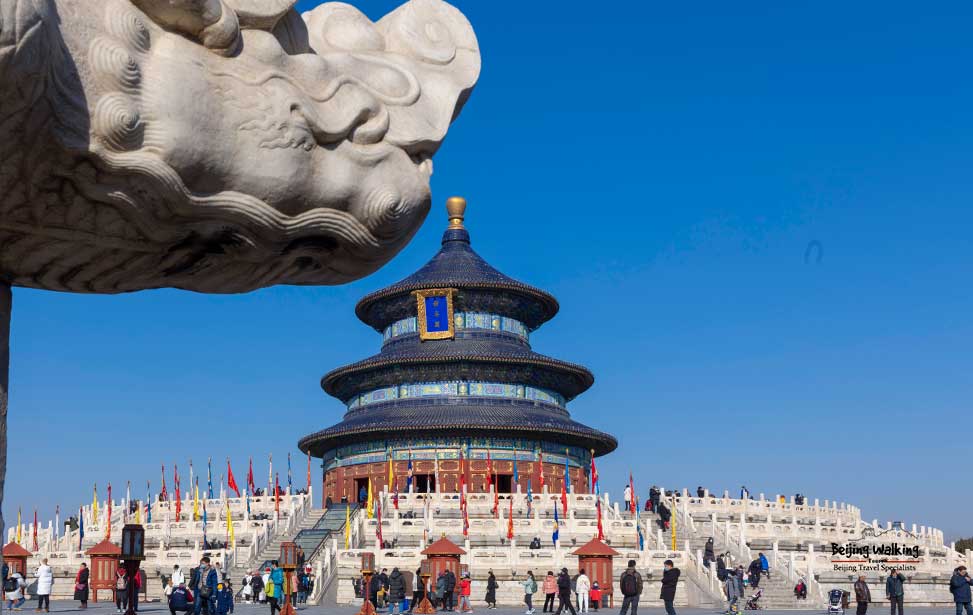
This is the most famous building of the Temple of Heaven. It is 31.78 meters high and has an integral structure with wooden parts of tenons and mortises. Its magnificent appearance could reasonably bear its weight and any outside force.
Echo Wall 回音壁
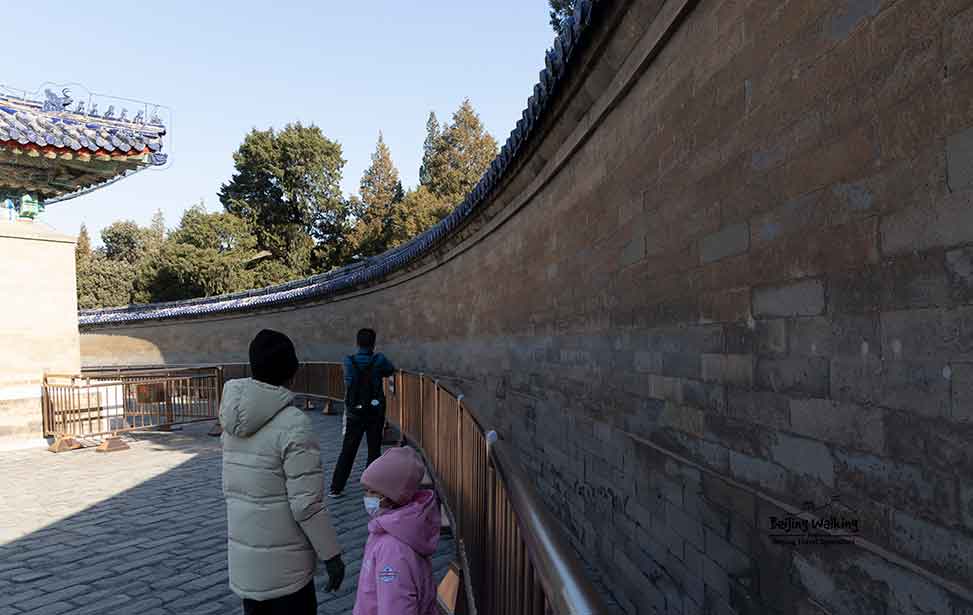
The echo wall is the wall of the Imperial Vault of Heaven. It is a suitable carrier of sound. It is very smooth, and the fence bricks are perfectly matched, creating a good echo sound effect; it was later named the Echo Wall.
Triple Sound Stones 三音石
If you stand on the first stone and call out, the sound will echo once; on the second stone, the sound will be heard twice; on the third stone, the sound will be repeated three times.
Circular Mound Altar 圆丘坛
The Circular Mound Altar was built in the 9th year of Ming Emperor Jiajing’s reign (1530). At the center of the upper terrace lies a round stone surrounded by nine concentric rings of stones. It is called the Heaven center stone. If you stand on the stone, you can hear thunderous echoes. Because it is at the same distance from 4 directions, the echo returns simultaneously. It is a must-do on your visit.
6. Interesting Stories of Temple of Heaven
The seven starts rock has eight rocks.
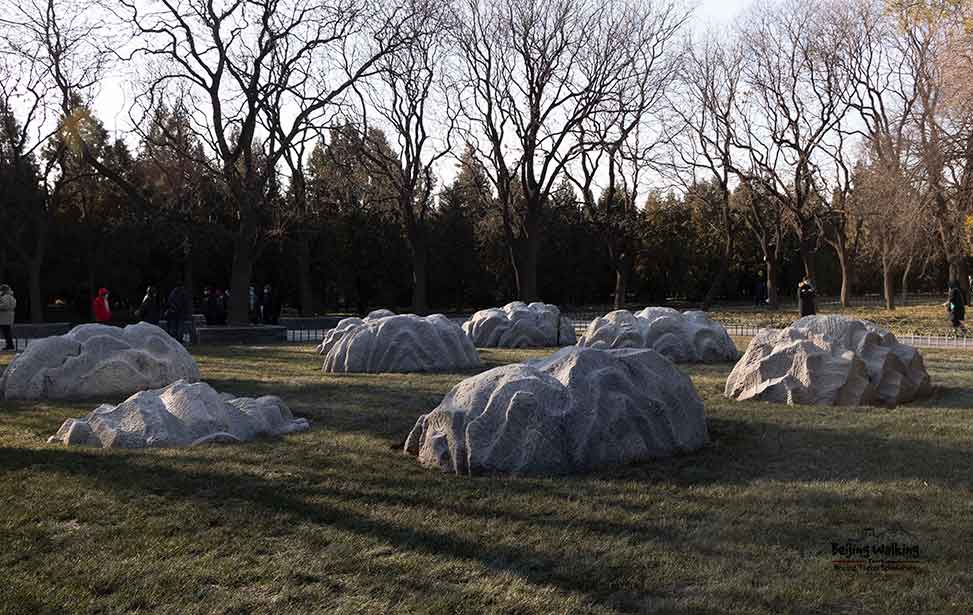
The 7-stars means the Big Dipper, which is put here for stabilizing purposes. The Temple of Heaven was built in the Ming Dynasty, but the Qing Dynasty still uses it here. Qing emperors were Manchu; they wanted to rule the Han people, who were the majority. They tried to make the Manchu and Han into one family, so they put a small rock on the northeast side. Do you notice that the Big Dipper has a small start next to them? It is hard to say they are not together. You can check it in the evening.
Why the temple of heaven built in the southeast of the Forbidden City?
In ancient China, there is an old saying, “Heaven South, earth North.” Heaven and earth are a pair of Ying-Yang (Yin-Yang saying). China is in the Northern Hemisphere; the sun is in the south most of the time. So, the south is considered super Yang for heaven. On the other hand, the north is Yin for the earth.
Beijing has an axis, and all the emperors’ palaces are on the axis. So, if he built the Temple of Heaven, it is not respectful as his throne directly faces the Temple where he used to worship his god. The sunrises are from the east, so the east is believed to be close to heaven. That’s why the Temple of Heaven was built southeast of the Forbidden City.
All the main building in the Temple of Heaven is round
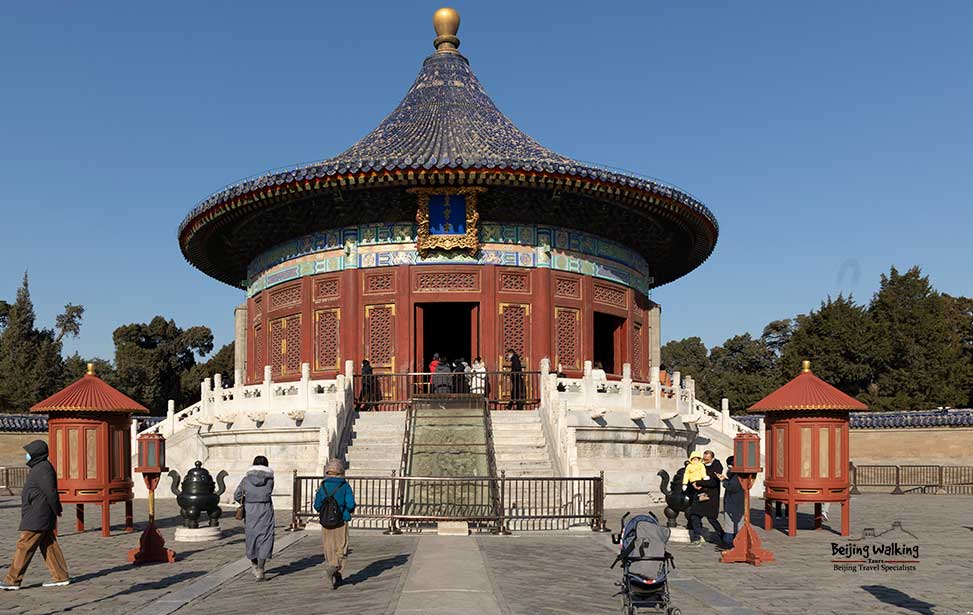
The Hall of Prayer for Good Harvest, the Imperial Vault of Heaven, and the Circular Mound Altar are all-round buildings. This is because the Chinese believed heaven was round and the earth was square in the old days.
What do the triple eaves of roofs mean?
The Hall of Prayer for Good Harvest is the most astonishing architectural structure in the Temple of Heaven. More Eaves means more critical. You can only find the building with two eaves levels in the Forbidden City and Confusion Temple. The Temple of Heaven built triple eaves to show sincere respect to Heaven.
How do people send an invitation to god for worship?
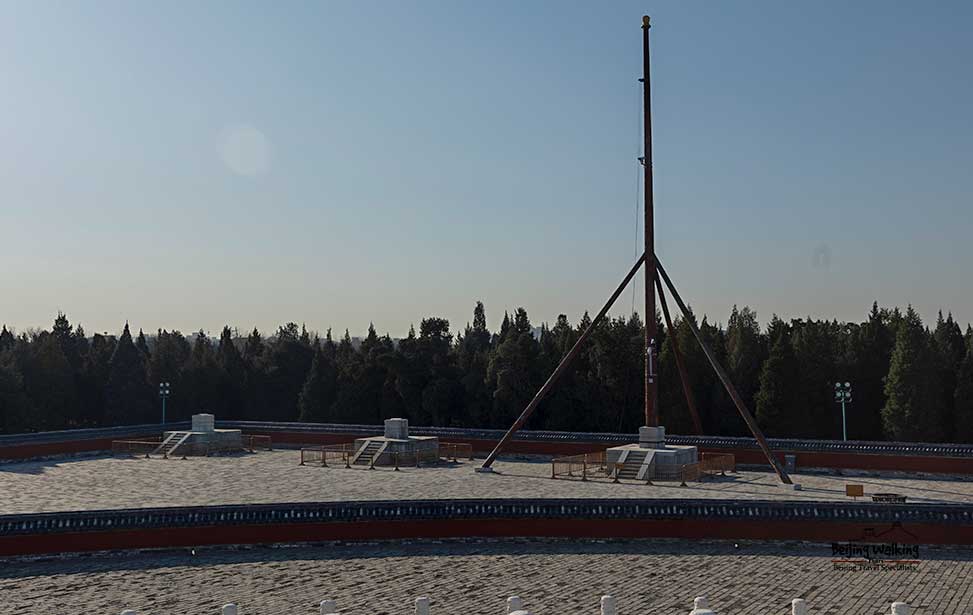
The temple of Heaven is built based on Taoism; a Jade Emperor who lives in Heaven sends his son to earth to rule the people, and his son is the emperor who lives in the Forbidden City. The emperor came to the Temple of Heaven yearly for the party ceremony, but how to let the god know? There are three high poles outside of the temple. When the ceremony starts, people put three giant lanterns on the top, which means they signal to the god there is a banquet for him.
The secret numbers
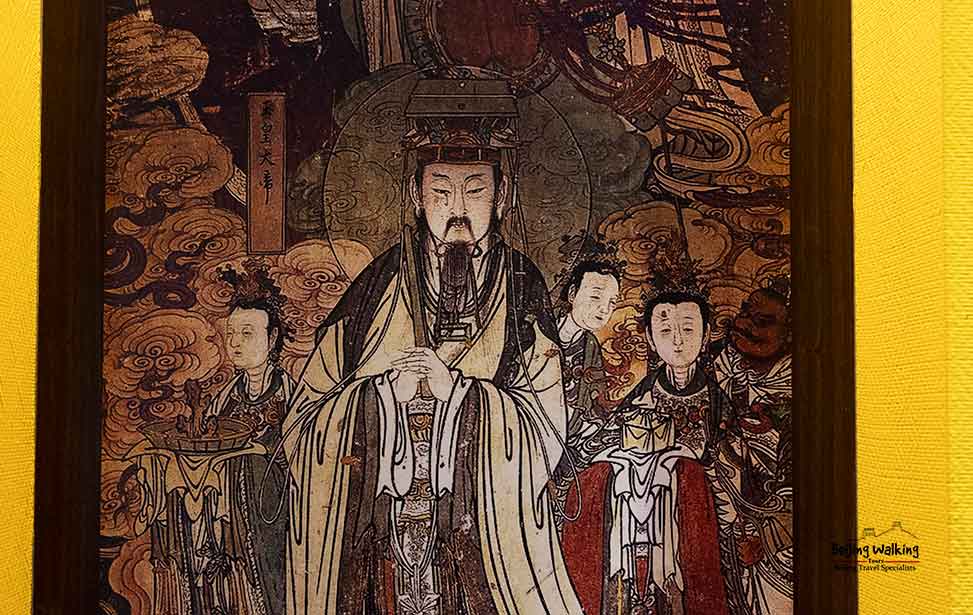
Number 9
To understand the secrets of 9 and 5, it is better to read 11 Forbidden City Facts You (Probably) Didn’t Know; I have described the relationship between 9 and 5. At the Circular Mound Altar, the upper terrace is 9 Zhang(=30 meters) in diameter, the middle terrace is 15 (3*5) Zhang in diameter, and the bottom terrace is 21 (3*7) Zhang in diameter. These figures involve the five Yang Numbers. (1,3,5,7,9) The sum of the diameters of the three layers of the terraces is 45 (5*9) Zhang.
At the center of the upper terrace lies a round stone surrounded by nine concentric rings of stones. The number of rocks in the first ring is 9, in the 2nd, it is 18, and so on, till 81 in the last 9th ring. The middle and bottom terraces also have nine rounds each. Ancient architects used the ultimate Yang number 9 to endow the Circular Mound Altar with the idea of the “Sublime.”
The Numbers in the Hall of Prayer for Good Harvest
The hall has 28 massive wooden pillars, forming inner, middle, and outer concentric rings of posts. The space between the two neighboring central seats represents spring, summer, autumn, and winter. The inner circle symbolizes the twelve months and 24 solar terms, and the outer ring symbolizes the twelve divisions of day and night.
7. FAQS
Is the Temple of Heaven open on Monday
Yes, it opens every day.
Can visitors enter the buildings inside the Temple of Heaven?
A: Visitors can enter some buildings within the Temple of Heaven complex, such as the Hall of Prayer for Good Harvests. However, access to certain areas may be restricted for preservation purposes.
Is the Temple of Heaven accessible to individuals with mobility challenges?
A: The Temple of Heaven complex is relatively accessible, with paved pathways and ramps in certain areas. However, some sections may have stairs or uneven surfaces. It’s advisable to check in advance for specific accessibility information or inquire at the site for assistance.
Things to do near the Temple of Heaven.
There are few tourist sites near the Temple of Heaven, but the Hongqiao Market is attractive. You can go there to get some nice souvenirs. There is a food court on the -1 floor where you can find all types of food.
Not far from the Temple of Heaven, you can walk to the Red Theater, where it has a super lovely Kongfu show at 7:30 pm. So if you are interested in the show, you can visit the Temple of Heaven in the afternoon and then have dinner near the Temple of Heaven. Go to watch the Kongfu show in the evening.
Serene Gardens and Parks:
Apart from its architectural wonders, the Temple of Heaven is surrounded by beautiful gardens and parks that offer a peaceful retreat from the bustling city. Stroll through the Cypress Grove Garden, the Long Corridor, and the Nine-Dragon Cypress—Marvel at the ancient trees, serene ponds, and colorful flower beds that create a harmonious atmosphere.
Visiting Beijing’s Temple of Heaven offers a profound journey into China’s cultural and spiritual heritage. Every aspect of this complex resonates with a sense of harmony and reverence, from the majestic architecture to the serene gardens.
